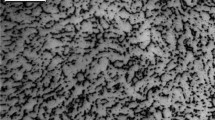Abstract
The differences of effective stress, effective strain, velocity field, and the load-time curves between the spider isothermal and non-isothermal forging processes are investigated by making full use of 3D FEA, and verified by the production experiment of spider forging. Effective stress is mainly concentrated on the pin, and becomes lower closer to the front of the pin. The maximum effective strain in the non-isothermal forging is lower than that in the isothermal. The great majority of strain in the non-isothermal forging process is 1.76, which is larger than the strain of 1.31 in the isothermal forging. The maximum load required in the isothermal forging is higher than that in the non-isothermal. The maximum experimental load and deformation temperature in the spider production are in good agreement with those in the non-isothermal FEA. The results indicate that the non-isothermal 3D FEA results can guide the design of the spider forging process.








Similar content being viewed by others
References
C.H. Lee and A.A. Polycarpou, A Phenomenological Friction Model of Tripod Constant Velocity (CV) Joints, Tribol. Int., 2010, 43, p 844–858
K. Lange, Some Aspects of the Development of Cold Forging to a High-Tech Precision Technology, J. Mater. Process. Technol., 1992, 35, p 245–257
S. Onodera and K. Sawai, Current Cold-Forging Techniques for the Manufacture of Complex Precision Near-Net-Shapes, J. Mater. Process. Technol., 1992, 35, p 385–396
Z. Gronostajski and M. Hawryluk, The Main Aspects of Precision Forging, Arch. Civil Mech. Eng., 2008, 8, p 39–55
X. Chen, Geometric Accuracy and Error Analysis of the Tripod Constant Velocity Joint, Shanghai Jiao Tong University, Shanghai, 2009
B.S. Shi, Standardization and Structure Design of the Main Parameters for Tripod Universal Joint, Bearing, 2008, 12, p 9–15
I. Watson, B.G. Prusty, and J. Olsen, Conceptual Design Optimization of a Constant-Velocity Coupling, Mech. Mach. Theory, 2013, 68, p 18–34
J.R. Cho and D.Y. Yang, Three-Dimensional Finite Element Simulation of a Spider Hot Forging Process Using a New Remeshing Scheme, J. Mater. Process. Technol., 2000, 99, p 219–225
A. Cherouat, K. Saanouni, and Y. Hammi, Improvement of Forging Process of a 3D Complex Part with Respect to Damage Occurrence, J. Mater. Process. Technol., 2003, 142, p 307–317
J.M. Yan, C.Y. Wang, W. Li, Z.C. Tian, and H.E. Zhang, Influences of Taper Angle of Punch on Radical Cold Extrusion Process of Three-Pillar Universal Joint Pin, Forg. Stamp. Technol., 2003, 38(2), p 81–84
Acknowledgments
The authors are grateful to be supported by Natural Science Foundation of Jiangsu Province, P. R. China under Grants BK2012594 and BK20131144, the Science Project of Changzhou, P. R. China under Grant CZ20130021, the Project Funded by the Priority Academic Program Development of Jiangsu Higher Education Institutions (PAPD) under Grant No. [2014]9, and the Ministry of Education and Science of the Russian Federation within the Framework of the Design Part of the State Task No. 11.2540.2014/K Educational Organization of Higher Education.
Author information
Authors and Affiliations
Corresponding author
Rights and permissions
About this article
Cite this article
Niu, L., Wei, W., Wei, K.X. et al. 3D Finite Element Analysis of Spider Non-isothermal Forging Process. J. of Materi Eng and Perform 25, 2536–2541 (2016). https://doi.org/10.1007/s11665-016-2108-2
Received:
Revised:
Published:
Issue Date:
DOI: https://doi.org/10.1007/s11665-016-2108-2




